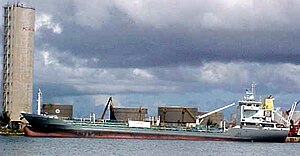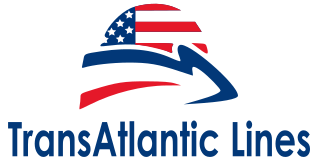
MV Virginian, formerly named the MV Strong Virginian (T-AKR-9205), is a combination container, heavy lift, and roll-on/roll-off ship. Owned and operated by Sealift Incorporated of Oyster Bay, New York, the ship is one of seventeen container—roll-on/roll-off ships in use by the Military Sealift Command, and one of 28 ships assigned to that organization's Sealift Program Office. The ship was previously known as the MV Saint Magnus and the MV Jolly Indaco.

The United States Merchant Marine is an organization composed of United States civilian mariners and U.S. civilian and federally owned merchant vessels. Both the civilian mariners and the merchant vessels are managed by a combination of the government and private sectors, and engage in commerce or transportation of goods and services in and out of the navigable waters of the United States. The Merchant Marine primarily transports domestic and international cargo and passengers during peacetime, and operate and maintain deep-sea merchant ships, tugboats, towboats, ferries, dredges, excursion vessels, charter boats and other waterborne craft on the oceans, the Great Lakes, rivers, canals, harbors, and other waterways. In times of war, the Merchant Marine can be an auxiliary to the United States Navy, and can be called upon to deliver military personnel and materiel for the military.

The Military Sealift Command (MSC) is an organization that controls the replenishment and military transport ships of the United States Navy. Military Sealift Command has the responsibility for providing sealift and ocean transportation for all US military services as well as for other government agencies. It first came into existence on 9 July 1949 when the Military Sea Transportation Service (MSTS) became solely responsible for the Department of Defense's ocean transport needs. The MSTS was renamed the Military Sealift Command in 1970.

Sealift is a term used predominantly in military logistics and refers to the use of cargo ships for the deployment of military assets, such as weaponry, vehicles, military personnel, and supplies. It complements other means of transport, such as strategic airlifts, in order to enhance a state's ability to project power.

USS Saugatuck (AO-75) was a Suamico-class replenishment oiler of the United States Navy.

USNS Joshua Humphreys (T-AO-188) is a Henry J. Kaiser-class replenishment oiler of the United States Navy. She was named for Joshua Humphreys, who designed the six original US Navy frigates. She entered service in 1987 and was placed in reserve just nine years later, but has twice been brought out of reserve and as of 2015 is once more on active duty.

USS Marias (AO-57) was a Cimarron-class fleet oiler acquired by the U.S. Navy during World War II. She served her country primarily in the Pacific Ocean Theatre of Operations, and provided petroleum products where needed to combat ships. For performing this dangerous task, she was awarded eight battle stars during World War II, and one campaign star during the Vietnam War for her bravery in combat areas.
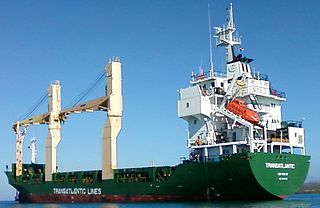
MV Maria Reina is a Panamanian container ship. The 100-metre (330 ft) long ship was built at Wuhu Shipyard in Wuhu, China in 1997 as Steamers Future. Originally owned by Singapore's Keppel Corporation, she has had three owners, been registered under three flags, and been renamed ten times.
Sealift Incorporated is an American shipping company based in Oyster Bay, New York. The privately held corporation was founded in 1975 by the four owners who remain the principal executives. Sealift Inc. is one of the largest ocean contractors for transporting U.S. food aid and participates in the Voluntary Intermodal Sealift Agreement. Between the start of fiscal 2000 and the first quarter of 2008, Sealift Inc. was awarded US$402,151,046 in contracts.

USNS Sgt. Andrew Miller (T-AK-242) was built as Victory ship SS Radcliffe Victory, a Boulder Victory-class cargo ship, built at the end of World War II. She served during the war and its demilitarization as a commercial cargo vessel operated by American West African Lines under charter with the Maritime Commission and War Shipping Administration. From 1946 to 1950, she served the US Army as a transport named USAT Sgt. Andrew Miller. In 1950, she was acquired by the US Navy and assigned to the Military Sea Transportation Service (MSTS). In 1981 she ended her career and was placed into reserve.

MV Kalia is a small double-hulled oil tanker managed by Adminros Shipmanagement Company, Ltd. and registered under the flag of Cyprus. The 109-meter-long ship has a nominal crew of 13 and can carry 30,000 barrels (4,770 m3) of oil. While known as the MV Montauk, the ship was owned by the American company Sealift Incorporated, and sailed under long-term charter to the United States Military Sealift Command where it transported oil for the U.S. Department of Defense.
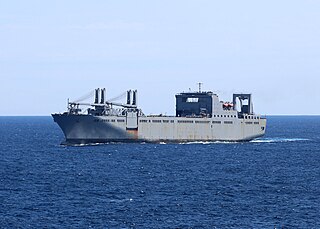
MV Leroy A. Mendonca, formerly USNS Mendonca (T-AKR-303), was a Bob Hope-class roll on roll off vehicle cargo ship of the United States Navy. She was built by Northrop Grumman Ship Systems, New Orleans and delivered to the Navy on 30 January 2001. They assigned her to the United States Department of Defense's Military Sealift Command. Mendonca is named for Medal of Honor recipient Sergeant Leroy A. Mendonca, and is one of 11 Surge LMSRs operated by a private company under contract to the Military Sealift Command. She was assigned to the MSC Atlantic surge force and is maintained in Ready Operational Status 4. On 26 September 2022, Mendonca left service and was stricken from the Naval Vessel Register.
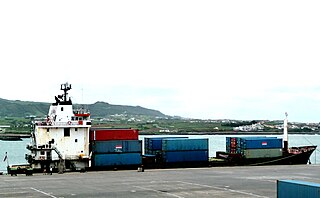
MV Geysir is a U.S.-flagged general cargo/container ship owned by TransAtlantic Lines LLC. Originally named Amazonia, the 90-meter ship was built by American Atlantic Shipping in 1980 to serve a route from the United States to Brazil. In 1983, the ship was seized by the United States Maritime Administration for nonpayment of government loans.
The Type C7 ship(Lancer Class) is a United States Maritime Administration (MARAD) designation for a cargo ship and the first US purpose-built container ship. The vessels were constructed in US shipyards and entered service starting in 1968. As US-built ships they were Jones Act qualified for shipments between US domestic ports. Under the Jones Act, domestic US maritime trade is restricted to US-built and flagged vessels of US owners and manned by predominantly US-citizen crews. The last active Lancer container-configured ship was scrapped in 2019. Lancers of the vehicle Roll-on/Roll-off (RO/RO) configuration remain held in the Ready Reserve Force, National Defense Reserve Fleet and the US Navy Military Sealift Command. All are steam powered.

The Maersk Peary is a tanker, operated by the shipping firm Maersk Line, that was designed for working in the polar regions.

USNS Victoria (T-AK-281) was a Norwalk-class fleet ballistic missile cargo ship, which was launched as a World War II commercial Victory cargo ship SS Ethiopia Victory under the Emergency Shipbuilding program. The Ethiopia Victory was acquired by the U.S. Navy in 1963.
